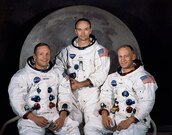
This month is the fiftieth anniversary of mankind’s first landing on the moon. July 1969! The BIG 5-0! The Apollo 11 mission was a “big deal” at that time in our history, and it is still a “big deal.”
Apollo 11 crew - Neil Armstrong, Michael Collins, Buzz Aldrin Photo y NASA - NASA Human Space Flight Gallery
Public Domain, https://commons.wikimedia.org/w/index.php?curid=102412
No doubt celebrations will be held, and we’ll be hearing a lot about the historical event in the media. I’m sure the movie will be on TV every night for longer than many of us would like. Possibly we’ll even hear from some of those who denied the event ever happened and believe the moon landing to be the biggest hoax of all times.
During this momentous anniversary, we focus primarily on the men who made the nearly 500,000 mile journey … as we should … but let’s not forget the other 400,000 people who made the flight possible. All those others scientists, engineers, technicians, and support staff necessary to deal with a vast number of system and subsystems necessary to put these men on the moon. That's a fair-sized city, not a village; one and a quarter person per mile.
I’m hoping, instead, that the American people in general will be exposed to one or all of the several American women who made the moon landing possible, in particular Margaret Hamilton, even though the US has yet to send a woman to the moon. Shame on us!
 PUT YOUR HANDS TOGETHER FOR MARGARET HAMILTON Without her, there would have been no moon landing. Official photo for NASA, 1989 - Photo source scientificwomen.net/hamilton-margaret |  |
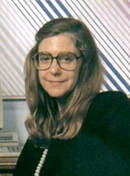
Hamilton and her husband moved to Boston, where James planned to attend Harvard Law School. Her plan was to attend Brandeis University to study abstract math after her husband graduated, but she accepted an interim position as a programmer at MIT, working on programs to predict weather. While she was at MIT she also did postgraduate work in meteorology. In the early 1960s she transferred to MIT’s Lincoln Laboratory where she worked on military air defense systems and wrote programs to identify enemy aircraft.
Hamilton at MIT Lincoln Laboratory, 1962
Credit: Margaret Hamilton; photo source:
Photo source: futurism.com/margaret-hamilton
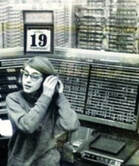
Hamilton moved on to a position at MIT’s Instrumentation Laboratory (which later became the independent Charles Stark Draper laboratory) and was there when NASA contracted with the Lab to develop the guidance systems for the Apollo Program.
She headed the team responsible for developing the software for the guidance and control systems of the in-flight command and lunar modules. In later interviews (years after the fact) Hamilton said that computer science and software engineering were not yet disciplines at the time. The scientists and programmers simply learned by doing -- apparently over and over -- until it worked.
She and her colleagues developed the paradigm ideas in programming writing the code for the world’s first portable computer. “When I first got into it, nobody knew what it was that we were doing. It was like the Wild West. There was no course in it. They didn’t teach it,” Hamilton said.
In his article for Wired.com, Robert McMillian quote Hamilton’s response to an interview question about what it was like being a female in that environment.
“Then, as now, “the guys” dominated tech and engineering. Like female coders in today’s diversity-challenged
tech industry, Hamilton was an outlier. It might surprise today’s software makers that one of the founding fathers
of their boys’ club was, in fact, a mother—and that should give them pause as they consider why the
gender inequality of the Mad Men era persists to this day … The world didn’t think much at all about software
back in the early Apollo days.”
As the project progressed, it soon became apparent how crucial the software was to the success of the mission. By 1965, Margaret was responsible for all the onboard flight software.
Margaret Hamilton inside mock-up of the command module.
Credit: MIT Photo Source: en.wikipedia.org//Margaret_Hamilton\
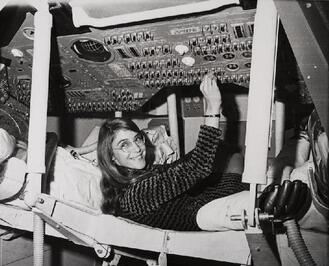
In my opinion, there’s a significant reason why Hamilton stands out among the many thousands of engineers, programmers, scientists, and all the people who contributed to the success of Apollo 11. Her foresight saved the mission.
In addition to being the Mother of the field of Software Engineering, Hamilton was also a real mother with a daughter, Lauren, who, at this time, was about four years old. She would bring Lauren with her to work in the evenings and
on weekends, and the child would sleep or play while her mother Margaret and her daughter, Lauren
other wrote programs for the Apollo’s command module computer. Photo source: hackaday.com/margaret-hamilton
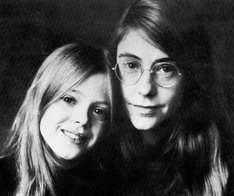
As a result, Hamilton wanted to add error-checking code to prevent a crash under these circumstances, but was overruled by her NASA superiors. This was not something that could happen in space because, Hamilton was told, “Astronauts do not make mistakes.” Instead she programmed a “program note” available to NASA engineers and astronauts that said “Do not select P01 during flight.” And as it turned out, the event that “could never happen,” happened.
On the fifth day of the Apollo 8 mission, Jim Lovell inadvertently selected P01 during the flight, which deleted all the navigation data the mission had collected. Without it, the computer wouldn’t be able to plot the course back to earth. Hamilton and her team spent nine hours figuring out a way to save the day, and brought Apollo 8 home to earth. After that Hamilton had no trouble convincing NASA to let her design error and recovery software for future missions.
And sure enough, there was a critical moment in the Apollo 11 mission where Hamilton’s foresight saved that mission as well. Just minutes before the Lunar lander neared the Moon’s surface, alarms went off indicating a computer overload “with interrupts caused by incorrectly phased power supplied to the lander’s rendezvous radar.” The alarms meant the computer couldn’t handle all the tasks at once. Because of the alarms built into the flight software’s error detection and recovery techniques, the mission, which came close to being scrubbed, managed to land on the moon. Dr. Paul Curto, senior technologist who nominated Hamilton for a NASA Space Art Award, called Hamilton’s work “the foundation for ultra-reliable software design.”
WHERE NO WOMAN HAS GONE BEFORE
Hamilton remained with MIT until the mid-1970s, then left to work in private industry. She cofounded several software companies, and in March 1986, she became the founder and CEO of Hamilton Technologies, Inc. in Cambridge, Massachusetts. The company was developed around the Universal Systems Language (USL) and its associated automated environment, the 001 Tool Suite, based on her paradigm of Development Before The Fact for systems design and software development. Her contributions to the field have continued throughout her career.
Based on what I read, one of the things that impressed me most about Margaret Hamilton was her constant focus on the human-computer connection, particularly in relation to the Apollo Missions. In 2009 she describer for MIT News her contributions to the Apollo software.
“From my own perspective, the software experience itself (designing it, developing it, evolving it, watching
it perform and learning from it for future systems) was at least as exciting as the events surrounding the mission.
Not only did it (the software) have to work, it had to work the first time. Not only did it have to be ultra-reliable,
it needed to be able to perform error detection and recovery in real time. … We took our work seriously, many of
us beginning this journey while still in our 20s. Coming up with solutions and new ideas was an adventure.
Dedication and commitment were a given. Mutual respect was across the board. Because software was a
mystery, a black box, upper management gave us total freedom and trust. We had to find a way and we did.
Looking back, we were the luckiest people in the world; there was no choice but to be pioneers.”
The world can thank Hamilton for expanding the notion of just what humanity could do on earth and beyond.
AWARDS
● 1986 - Hamilton received the Augusta Ada Lovelace Award, an honor bestowed by The Association for Women in Computing on individuals, men and women, who have excelled in two areas of endeavor: 1) Outstanding scientific and technical achievement, and 2) Extraordinary service to the computing community through their accomplishments and contributions on behalf of women in computing. (P.S. If you don't know who Ada Lovelace was, that will be coming.)
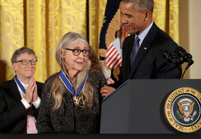
● 2009 - Outstanding Alumni Award from Earlham College.
● 2016 - Presidential Medal of Freedom from Barack Obama, the highest
civilian award in the United States. PhotoSource: hackaday.com/2018/margaret-hamilton
● 2017 - Computer History Museum Fellow Award, recognizing exceptional men and women whose computing ideas have changed the world.
● 2017 - A "Women of NASA" LEGO set went on sale featuring (among other things) mini-figurines of Hamilton, Mae Jemison, Sally Ride, and Nancy Grace Roman.
● 2018 – Hamilton was invested honoris causa by the Polytechnic University of Catalonia.
It saddens me (and angers me, a little) to point out that this is the 50th anniversary of the moon landing, to which Margaret Hamilton made such a large contribution, and almost twenty years passed before she was honored for her work. The rest of the honors have been awarded after the year 2000. Better Late Than Never.
□
Sources:
https://www.wired.com/2015/10/margaret-hamilton-nasa-apollo/
https://publications.computer.org/software-magazine/2018/06/08/margaret-hamilton-software-engineering-pioneer-apollo-11/
https://futurism.com/margaret-hamilton-the-untold-story-of-the-woman-who-took-us-to-the-moon
https://www.britannica.com/biography/Margaret-Hamilton-American-computer-scientist
https://en.wikipedia.org/wiki/Margaret_Hamilton_(scientist)
https://sservi.nasa.gov/?question=first-woman-on-the-moon
http://news.mit.edu/2016/apollo-code-developer-margaret-hamilton-receives-presidential-medal-of-freedom-1117
https://www.wired.com/2015/10/margaret-hamilton-nasa-apollo/
https://hackaday.com/2018/04/10/margaret-hamilton-takes-software-engineering-to-the-moon-and-beyond/
https://www.makers.com/profiles/596e0f42bea17725160a95c1
https://en.wikipedia.org/wiki/Moon_landing_conspiracy_theories
https://airandspace.si.edu/explore-and-learn/topics/apollo/apollo-program/landing-missions/apollo11.cfm
https://www.theguardian.com/science/2009/jul/02/apollo-11-back-up-team
https://www.space.com/18145-how-far-is-the-moon.html
https://www.britannica.com/biography/Margaret-Hamilton-American-computer-scientist
http://news.mit.edu/2016/scene-at-mit-margaret-hamilton-apollo-code-0817
 RSS Feed
RSS Feed